Showa-Retro City of Onomichi and Breezy Shimanami Kaido
This time I visited the commercial port city of Onomichi, which still retains the good-old ambience of the Showa period (1926–89), and the Shimanami Kaido road, which extends for about 60 kilometers across the picturesque Seto Inland Sea linking Onomichi on Japan’s main island of Honshu with Imabari on Shikoku. In April of this year Onomichi was designated as a “Japanese Heritage” by the Agency for Cultural Affairs, and in June the Japan Tourism Agency chose the Setouchi Sea Route, including Shimanami Kaido, as one of the wide-area tourist routes publicized to attract foreigners to Japan. The following is an introduction to Onomichi and the Shimanami Kaido route, which are expected to become increasingly popular among tourists.
Strolling around the Commercial City of Onomichi
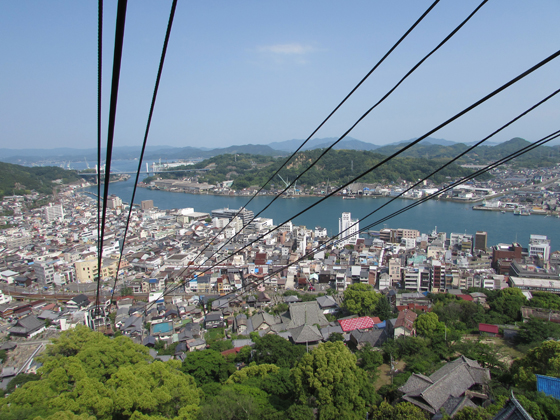
View of Onomichi Suido channel from Mount Senkoji Ropeway
Breathtaking Stroll in Senkoji Park
Onomichi is a commercial port city that flourished as a distribution relay station from as early as the Kamakura period (1185–1333). Senkoji Park, which can be reached by taking the ropeway to the summit of Mount Senkoji, offers a panoramic view of the city. The old townscape stretching along the coastline includes stores that were founded more than a century ago, and in the shipyard on the opposite coast large cranes that have been active since the early Showa days move up and down.
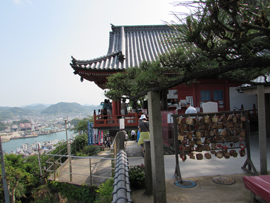
Senkoji temple (founded in 806)
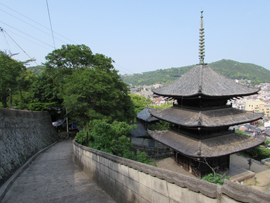
The three-storied pagoda in the precincts of Tenneiji temple
At Senkoji temple, which is located in a corner of the park and is the symbol of Onomichi, there were many people offering prayers and purchasing good luck charms in the hope of doing well in business or getting protection from evil spirits. A cobbled path led me down from the park to the Neko no Hosomichi narrow Road of Cat, which, as its name suggests, is frequented by cats. There are many cats roaming around the numerous alleyways in Tokyo’s Yanaka district too. But with the abundant greenery and peaceful atmosphere here in Onomichi, this place must be absolute bliss for them.

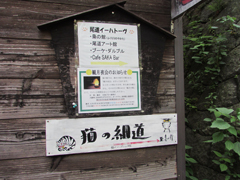
Neko no Hosomichi (Path of Cats)

Showa-Like Ambience of Onomichi’s Main Shopping Street
Bidding farewell to our feline friends, next I headed for Onomichi Hon-dori Shotengai, a shopping street that still exudes the look and ambience of the good-old Showa days. The 1.6-km arcade includes craft shops, restaurants, clothing and general goods stores, clinics, and banks. For local residents and tourists alike, it is a convenient and pleasant street.
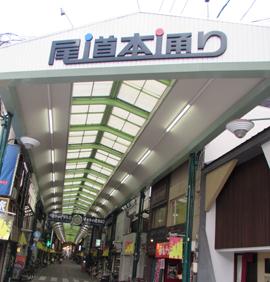
Entrance to Onomichi Hon-dori shopping street
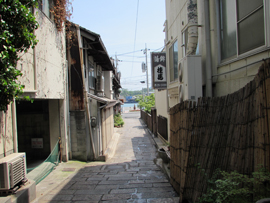
An alleyway off Onomichi Hon-dori shopping street
Keima Kamaboko Shoten, which trades in kamaboko (boiled fish paste), was founded more than 100 years ago and has fans among both local people and visitors from outside the prefecture. The Keima store uses fresh fish from the Seto Inland Sea, and its products are very healthy because they contain no additives or preservatives. Samples are available, so by all means try them. The traditional taste cherished by such notable figures as the novelist Naoya Shiga (1883–1971) remains unchanged to this day.
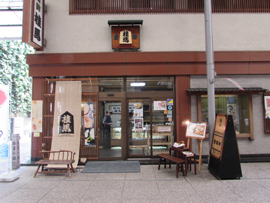
Keima Kamaboko Shoten (founded in 1912)
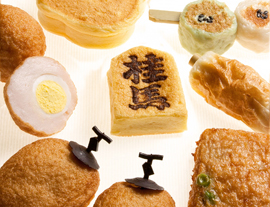
A great variety of kamaboko
Leaving Keima, right in front of me I saw a Showa-style coffee shop called Mexico. “I’ve been running this coffee shop here for more than 60 years,” said the owner Ms. Teruko Kawajiri with a smile as she prepared a cup of coffee for me. “In the past a lot of senior high school students used to come in on their way back from school, and they were so boisterous. But there are not so many kids around these days, and they don’t come here at all. In their place foreign tourists occasionally come in. I haven’t closed the shop for a single day ever since January, but I don’t feel tired at all. I’m as fit as a fiddle if nothing else!” And the secret of Ms. Kawajiri’s good health? “I’m so well because I drink five cups of freshly roasted coffee every day!” The tasty coffee and pleasant chat with Ms. Kawajiri were very soothing indeed.
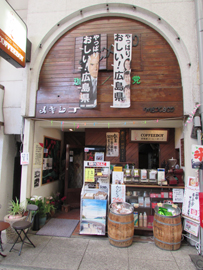
Mexico coffee shop
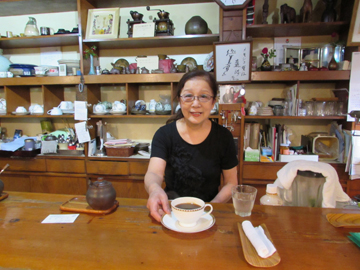
Ms. Teruko Kawajiri, Mexico's owner
Even along the nostalgic Onomichi Hon-dori shopping street, the imposing façade of Yamasaki Kiyoharu Shoten, founded in 1919, stands out. This store is a rarity in Japan in that it handles both artistic swords, knives, and tools, including Japanese swords, and knives for everyday use. Special mention should be made of its stock of swords received from the Tokugawa and Shimazu clans and others. Mr. Kiyomitsu Yamasaki, the fourth-generation owner, told me, “We sell a lot of sword guard belt buckles and key holders with sword guards to foreigners!” This famous store is a must for aficionados.
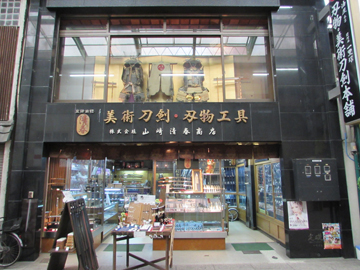
Yamasaki Kiyoharu Shoten, a long-established store selling both artistic swords and kitchen knives

Belts and key holders with sword guards
For a moment I thought I spied a public bathhouse right in the middle of the shopping street, but on closer scrutiny I saw that it was actually a café with a corner for selling local produce of Onomichi and other souvenirs. Called Yuyu, this very retro establishment is a renovation of a public bathhouse called Yamatoyu that operated here for about 100 years. In the café I ordered honey and lemon juice, a blend of local lemons and honey. The sourness of the lemons and sweetness of the honey left a refreshing feel on my parched throat.
Strolling around Onomichi is like taking a nostalgic step back into the Showa era.

Yuyu (Yamatoyu)
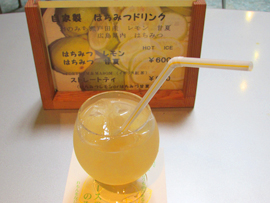
Home-made honey and lemon juice
Shimanami Kaido road
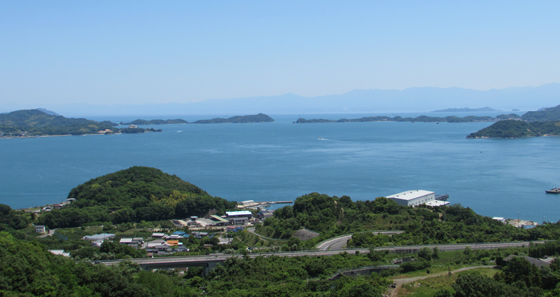
View of Seto Inland Sea from near Citrus Park Setoda
Shimanami Kaido Popular among Foreigners Too
It was a fine morning as I headed for the Onomichi Rent-a-Cycle Terminal, the starting point of Shimanami Kaido (Sea Route) on the Honshu side. People can choose the most suitable cycle for them from the 100 bicycles for rent, which include city bikes (commonly known in Japan as mamachari, or mom’s bike) and hybrid bicycles for more experienced cyclists. Many foreigners also come here, so there is an English-language information board as well.

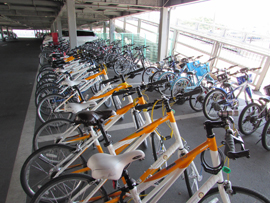
The rent-a-cycle terminal at Onomichi Port
I asked a Spanish and Japanese couple who were about to set off on rented bicycles about their trip. “I took two weeks off from my job in Spain to come to Japan for sightseeing,” replied Mr. Rafael Hitos, a company employee back home. “I’m looking forward to seeing the beautiful islands of Shimanami Kaido. After that, we’re scheduled to go to see Matsuyama Castle and Dogo Onsen in Ehime Prefecture, then take a ferry from Matsuyama to Hiroshima Prefecture to see Miyajima [Itsukushima], and then go up to Kyoto.” “We’re going to ride along Shimanami Kaido for two days, but I’m a little worried because we haven’t decided where we are going to stay tonight,” said his partner, Ms. Yoko Shimakage, rather anxiously. But although she clearly felt some concern about the trip they were embarking on, you could also see a twinkle in her eyes.
Since there were so many places that I wanted to see and so little time in which to do so, I gave up on the idea of renting a bicycle and decided to cross Shimanami Kaido by rented car instead.
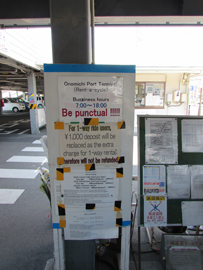
Rent-a-cycle guide in English
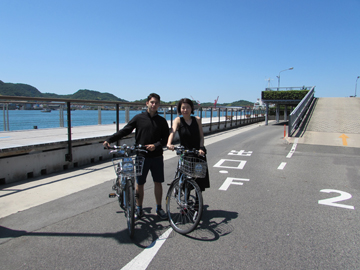
Mr. Rafael Hitos and Ms. Yoko Shimakage
The Fearsome Murakami Suigun Pirates
The islands of the Seto Inland Sea that I was heading for were once the home of pirates who were well known not only in Japan but also across the Korean Peninsula, China, and Southeast Asia. These pirates, known collectively as Murakami Suigun, consisted of three clans that were active in the Muromachi period (1333–1568), from the Northern and Southern Courts era (1334–92) to the Warring States era (1467–1568). Specifically there were three Murakami brothers known locally as the “three-island Murakamis,” because each one of them controlled an island. The elder brother, Yoshiaki, had control of Noshima island; the second brother, Akitada, had control of Kurushima island; and the third brother, Akinaga, had control of Innoshima island.
My first stop was Innoshima Suigun Castle on the island of Innoshima, which has an unusual museum displaying exhibits related to the Murakami pirates. The Murakami pirates controlled marine transportation in the Seto Inland Sea and exerted an influence on domestic military and political affairs as well. Below the castle there is Konrenji temple, where the sprawling cemetery is said to contain the graves of the Innoshima Murakami clan and its retainers. One certainly comes away with a feeling of the ups and downs of history.

Innoshima Suigun Castle
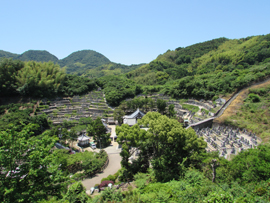
Cemetery at Konrenji temple
Citrus Fruits from around the World
Onomichi is one of the leading citrus-growing regions in Japan. The honey and lemon juice that I drank at Yuyu in the Onomichi Hon-dori shopping arcade was certainly very delicious indeed. I visited Citrus Park Setoda on Ikuchijima island, where about 500 types of citrus from around the world are on display. In the Citrus Pavilion various types of lemon and mandarin orange trees colorfully bear fruit, and in the Fragrance Hall visitors can enjoy seasonal aromas throughout the year.

Citrus Park Setoda
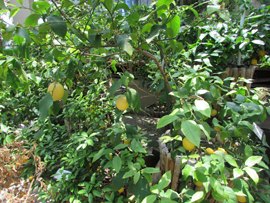
Lemons in the Citrus Pavilion
Romance of Japan’s Most Powerful Pirates
I wanted to learn more about pirates, so I visited the Imabari City Murakami Suigun Museum on the island of Oshima. This museum introduces the lives, weapons, and shipping gear of pirates in the Edo period (1603–1868) and also exhibits old documents, surcoats, and other items relating to the Noshima Murakami clan. Exhibits include fascinating weapons and tools used by the pirates to capture ships passing by without regard for the maritime checkpoints, such as a kumade (long rake) used to hook onto and pull in vessels; a sodegarami (long barbed pole) used to entangle a person’s clothes so that he could not move; and a small cannon called a kosonho.
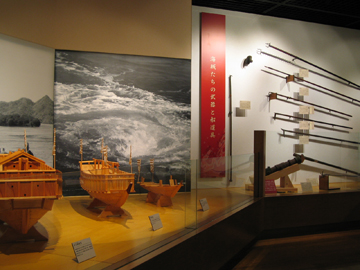
Models of ship and gear used by pirates
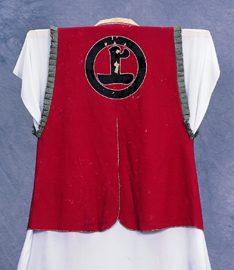
Models of ship and gear used by pirates

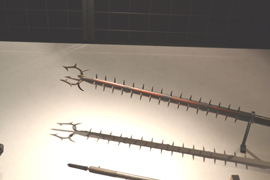
Kumade (left) and sodegarami (right) used in skirmishes
Despite these policing measures, skirmishes still occurred in the area. But navigation here is tricky because of the rapid currents, so how on earth did they fight? The Murakami pirates answered thus: “Don’t ride your boat, ride the currents!” In other words, read the currents well.
What fine words! The ride along Shimanami Kaido is certainly brimful of excitement and romance.
Small cannon, called a kosonho
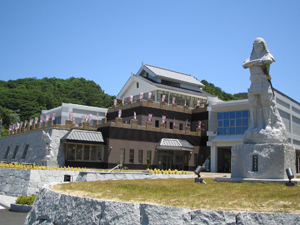
Full view of Imabari City Murakami Suigun Museum
Cooperation and photos:
Imabari City Murakami Suigun Museum
http://www.city.imabari.ehime.jp/bunka/suigun/ (Japanese only)
